Improvement of the Soil and Water Assessment Tool Model and Its Application in a Typical Glacial Runoff Watershed: A Case Study of the Qarqan River Basin, China
Abstract
:1. Introduction
2. Materials and Methods
2.1. Study Area Overview
2.2. Data Materials
2.2.1. DEM
2.2.2. Land Use and Soil Data
2.2.3. Meteorological Data
2.2.4. Glacier Data
2.3. Setting Up SWAT-Gla Model Based on Original SWAT
2.3.1. Glacial Volume Calculation
2.3.2. Calculation of the Daily Melting of the Glacier
2.3.3. Calculate the Daily Accumulation of the Glacier
2.3.4. Dynamic Glacial Volume Calculation
2.3.5. Establishing the SWAT-Gla Model
3. Results
3.1. Sensitivity Analysis of SWAT-Gla Model Parameters
3.2. Comparison of SWAT and SWAT-Gla Simulation Results
3.3. Water Resource Analysis in Qarqan River Basin
3.3.1. Water Resource Characteristics Analysis
3.3.2. Glacial Meltwater Runoff Characteristics Analysis
3.3.3. Groundwater Runoff Characteristics Analysis
4. Discussion
4.1. Performance of SWAT-Gla Model
4.2. Changes in Glacial Meltwater Resources in the Qarqan River Basin
4.3. Changes in Groundwater Resources in the Qarqan River Basin
5. Conclusions
Author Contributions
Funding
Institutional Review Board Statement
Informed Consent Statement
Data Availability Statement
Conflicts of Interest
References
- Pang, J.P.; Xu, Z.X.; Liu, C.M. SWAT Model Application: State-of-the-Art Review. Res. Soil Water Conserv. 2007, 14, 31–35. [Google Scholar]
- Zhang, L.M.; Wang, H.; Meng, X.Y. Application of SWAT Model Driven by CMADS in Hunhe River Basin in Liaoning Province. J. North China Univ. Water Resour. Electr. Power (Nat. Sci. Ed.) 2017, 38, 1–9. [Google Scholar]
- Xia, J.; Zuo, Q.T. Advances in International Hydrological Science Research. Adv. Earth Sci. 2006, 21, 256–261. [Google Scholar]
- Li, C.F.; Gao, J.F.; Cao, H. Impacts of land-use change on water resources Current status and trends of research. Soils 2002, 45, 191–196+205. [Google Scholar] [CrossRef]
- Wang, Y.L.; Wang, X.; Yang, Z.F.; Tan, Y.Y. Progress in the Research and Application of Uncertainty Analysis Methods for Hydrological System. Prog. Geogr. 2011, 30, 1167–1172. [Google Scholar]
- Perez-Valdivia, C.; Cade-Menun, B.; McMartin, D.W. Hydrological modeling of the pipestone creek watershed using the Soil Water Assessment Tool (SWAT): Assessing impacts of wetland drainage on hydrology. J. Hydrol. Reg. Stud. 2017, 14, 109–129. [Google Scholar] [CrossRef]
- Bhatta, B.; Shrestha, S.; Shrestha, P.K.; Talchabhadel, R. Evaluation and application of a SWAT model to assess the climate change impact on the hydrology of the Himalayan River Basin. Catena 2019, 181, 104082. [Google Scholar] [CrossRef]
- Wang, X.L.; Luo, Y.; Sun, L.; Shafeeque, M. Different climate factors contributing for runoff increases in the high glacierized tributaries of Tarim River Basin, China. J. Hydrol. Reg. Stud. 2021, 36, 100845. [Google Scholar] [CrossRef]
- Fang, G.H.; Yang, J.; Chen, Y.; Li, Z.; Ji, H.; De Maeyer, P. How Hydrologic Processes Differ Spatially in a Large Basin: Multisite and Multiobjective Modeling in the Tarim River Basin. J. Geophys. Res. Atmos. 2018, 123, 7098–7113. [Google Scholar] [CrossRef]
- He, K.L. Multi-Source Precipitation Data Fusion and Its Application over the Tibetan Plateau. Master’s Thesis, Xihua University, Chengdu, China, 2022. [Google Scholar]
- Sun, R.; Zhang, X.Q. Muskingum Model Parameters Recognition Based on Immune Particle Swarm Algorithm. J. China Hydrol. 2010, 30, 28–32+47. [Google Scholar]
- Bliss, A.; Hock, R.; Radić, V. Global response of glacier runoff to twenty-first century climate change. J. Geophys. Res. Earth Surf. 2014, 11, 717–730. [Google Scholar] [CrossRef]
- Zhao, H.; Li, H.; Xuan, Y.; Li, C.; Ni, H. Improvement of the SWAT Model for Snowmelt Runoff Simulation in Seasonal Snowmelt Area Using Remote Sensing Data. Remote Sens. 2022, 14, 5823. [Google Scholar] [CrossRef]
- Meng, X.Y.; Ji, X.N.; Liu, Z.H.; Xiao, J.C.; Chen, X.; Wang, F. Research on Improvement and Application of Snowmelt Module in SWAT. J. Nat. Resour. 2014, 29, 528–539. [Google Scholar]
- Zhang, Q.M. Temporal and Spatial Variation of the Typical Glaciers Activity Analysis with Multi-Source Spaceborne Imagery in Qinghai-Tibet Plateau. Master’s Thesis, China University of Mining & Technology, Xuzhou, China, 2022. [Google Scholar]
- Wu, X.J.; Shen, Y.P.; Wang, N.L.; Pan, X.D.; Zhang, W.; He, J.Q.; Wang, G.Y. Coupling the WRF model with a temperature index model based on remote sensing for snowmelt simulations in a river basin in the Altay Mountains, north-west China. Hydrol. Process. 2016, 30, 3967–3977. [Google Scholar] [CrossRef]
- Peng, J.J.; Xu, L.P.; Cao, C. Spatio-temporal evolution of glacier landscape pattern in the Yarkant River Basin from1991 to 2017. Acta Ecol. Sin. 2022, 42, 8265–8275. [Google Scholar]
- Song, X.Y.; Xu, M.; Li, Z.Z.; Yang, C.D. Study on Variation Characteristics of Extreme Climate and Its Impacts on Runoff in Yarkant Basin. J. China Hydrol. 2023, 43, 52–57. [Google Scholar] [CrossRef]
- Wu, Y.N. The Study on Evaluation and Distribution of Ecoenvironmental Sensitivity in the Middle and Lower Reaches of Che’erchen River. Master’s Thesis, Xinjiang University, Urumqi, China, 2008. [Google Scholar]
- Zhu, G.; Gao, H.J.; Zeng, G.; Jin, M.S. Variation of Wetland Landscape Pattern and Its Ecological Effects in the Green Corridor of the Arid Inland in Northwest China: A Case Study of the Lower Reaches of the Qarqan River. Remote Sens. Nat. Resour. 2010, 23, 219–223. [Google Scholar]
- Abdimijit, A.; Alimujiang, K.; Alishir, K.; Manzira, T. The Cherchen River watershed in Xinjiang: Macroscopic spatiotemporal variation, controlling and driving effects. J. Glaciol. Geocryol. 2015, 37, 480–492. [Google Scholar] [CrossRef]
- Liu, Y.S.; Ding, J.Y.; Zhan, Y.; Shangguan, D.H.; Liu, J.; Han, H.D.; Wang, J.; Xie, C.W. Impact of the Glacial Change on Water Resources in the Tarim River Basin. Acta Geogr. Sin. 2006, 61, 482–490. [Google Scholar]
- Da, W.; Wang, S.F.; Shen, Y.P.; Chen, A.A.; Mao, W.Y.; Zhang, W. Hydrological response to the climatic changes in the Qarqan River basin at the northern slope of Kunlun Mountains during 1957–2019. J. Glaciol. Geocryol. 2022, 44, 46–55. [Google Scholar] [CrossRef]
- Wang, R.H.; Sun, H.B.; Zhao, Z.Y. Analysis on the Mechanism and Driving Forces of Land Use/cover Change in the Qiemo Oasis, Xinjiang. Arid Land Geogr. 2005, 28, 849–855. [Google Scholar] [CrossRef]
- Liu, T.T.; Zhu, X.F.; Guo, R.; Xu, K.; Zhang, S.Z. Applicability of ERA5 reanalysis of precipitation data in China. Arid Land Geogr. 2022, 45, 66–79. [Google Scholar]
- Meng, X.G.; Guo, J.J.; Han, Y.Q. Preliminarily assessment of ERA5 reanalysis data. J. Mar. Meteorol. 2018, 38, 91–99. [Google Scholar] [CrossRef]
- Yao, F.; Yang, X.Q.; Liu, M.J.; Zhang, Y.Q. Performance Evaluation of ERA5 Reanalysis Precipitation Data in the Yangtze River Delta. J. Soil Water Conserv. 2022, 36, 178–189. [Google Scholar] [CrossRef]
- Liu, T.T.; Zhu, X.F.; Zhang, S.Z.; Xu, K.; Guo, R. Applicability analysis of ERA5 reanalysis surface air temperature data in China. J. Trop. Meteorol. 2023, 39, 78–88. [Google Scholar] [CrossRef]
- Shan, S.; Shen, R.P.; Shi, C.X.; Bai, L.; Sun, S. Evaluation of Land Surface Temperature and 2 m Air Temperature from Five Reanalyses Datasets across North China in Winter. Plateau Meteorol. 2020, 39, 37–47. [Google Scholar] [CrossRef]
- Ma, Y.; Liu, J.; Mamtimin, A.; Aihaiti, A.; Xu, L. Validation of FY-4A Temperature Profiles by Radiosonde Observations in Taklimakan Desert in China. Remote Sens. 2023, 15, 2925. [Google Scholar] [CrossRef]
- Wei, X.N.; Long, A.H.; Ying, Z.L.; Yu, J.W. Simulation of response of glacier runoff to climate change in the Hotan River Basin. Water Resour. Prot. 2022, 38, 137–144. [Google Scholar] [CrossRef]
- Touseef, M.; Chen, L.; Chen, H.; Gabriel, H.F.; Yang, W.; Mubeen, A. Enhancing Streamflow Modeling by Integrating GRACE Data and Shared Socio-Economic Pathways (SSPs) with SWAT in Hongshui River Basin, China. Remote Sens. 2023, 15, 2642. [Google Scholar] [CrossRef]
- Wu, L.Z.; Li, X. Dataset of the First Glacier Inventory in China; Cold and Arid Regions Science Data Center at Lanzhou: Lanzhou, China, 2004. [Google Scholar] [CrossRef]
- Liu, S.Y.; Guo, W.Q.; Xu, J.L. The second Chinese glacier inventory: Data, methods and results. J. Glaciol. 2015, 61, 357–372. [Google Scholar] [CrossRef]
- Huang, T.; Wu, Z.; Xiao, P.; Sun, Z.; Liu, Y.; Wang, J.; Wang, Z. Possible Future Climate Change Impacts on the Meteorological and Hydrological Drought Characteristics in the Jinghe River Basin, China. Remote Sens. 2023, 15, 1297. [Google Scholar] [CrossRef]
- Gebeyehu, B.M.; Jabir, A.K.; Tegegne, G.; Melesse, A.M. Subbasin Spatial Scale Effects on Hydrological Model Prediction Uncertainty of Extreme Stream Flows in the Omo Gibe River Basin, Ethiopia. Remote Sens. 2023, 15, 611. [Google Scholar] [CrossRef]
- Brock, B.W.; Willis, I.C.; Sharp, M.J.; Arnold, N.S. Modelling seasonal and spatial variations in the surface energy balance of Haut Glacier d’Arolla, Switzerland. Ann. Glaciol. 2000, 31, 53–62. [Google Scholar] [CrossRef]
- Chen, J.Z.; Qin, X.; Wu, J.K.; Du, W.T.; Sun, W.J.; Liu, Y.S.; Huang, Z.; Yang, J.H. Simulating the energy and mass balances on the Laohugou Glacier No.12 in the Qilian Mountains. J. Glaciol. Geocryol. 2014, 36, 38–47. [Google Scholar] [CrossRef]
- Li, J.J.; Li, J.; Wu, L.X.; Wang, Y.Z.; Guo, L. Simulating surface energy and mass balance of the Puruogangri ice cap during 2012–2014 based on High Asia Refined analysis data. Arid Zone Res. 2021, 38, 919–929. [Google Scholar] [CrossRef]
- Li, H.L.; Wang, P.Y.; Li, Z.Q.; Jin, S.; Xun, C.H.; Liang, P.B.; Yue, X.Y.; Yang, M. Study on the energy-mass balance simulation of the east branch of the Urumqi Glacier No.1, Tianshan Mountains. J. Glaciol. Geocryol. 2021, 43, 24–35. [Google Scholar] [CrossRef]
- Liu, W.G.; Xiao, C.D.; Liu, J.S.; Wang, J.; Wang, H.; Liu, J.F.; Liu, N.; Zhang, T.; Lin, X.; Deng, S.G. Study of the degree-day factors on the Rongbuk Glacier in the Mt. Qomolangma, Central Himalayas. J. Glaciol. Geocryol. 2014, 36, 1101–1110. [Google Scholar]
- Wang, T.X. Manas River Basin Based on Distributed Degree Day Model Study on Glacier Material Balance. Master’s Thesis, Shihezi University, Shihezi, China, 2022. [Google Scholar]
- Liu, J.; Zhang, W.; Xia, J.; Shen, Y.P.; Kang, S.C. Study of degree-day model from 2000 to 2016: The main progress and key issues. J. Glaciol. Geocryol. 2017, 39, 801–810. [Google Scholar]
- Braithwaite, R.J.; Zhang, Y. Sensitivity of mass balance of five Swiss glaciers to temperature changes assessed by tuning a degree-day model. J. Glaciol. 2000, 46, 7–14. [Google Scholar] [CrossRef]
- Fang, X.Y.; Li, Z.Q.; Bernd, W.; Gao, S.; Chen, R.S. Physical energy-balance and statistical glacier melting models comparison and testing for Shiyi Glacier, Heihe River Basin, Qilian M ountains, China. J. Glaciol. Geocryol. 2015, 37, 336–350. [Google Scholar] [CrossRef]
- Hock, R. Glacier melt: A review of processes and their modeling. Prog. Phys. Geogr. 2005, 29, 362–391. [Google Scholar] [CrossRef]
- William, P.K.; Albert, R.; Remko, U. A simple energy budget algorithm for the snowmelt runoff model. Water Resour. Res. 1994, 30, 1515–1527. [Google Scholar] [CrossRef]
- Wang, X.; Luo, Y.; Sun, L.; He, C.; Zhang, Y.; Liu, S. Attribution of runoff decline in the Amu Darya River in Central Asia during 1951–2007. J. Hydrometeorol. 2016, 17, 1543–1560. [Google Scholar] [CrossRef]
- Yin, Z.; Feng, Q.; Liu, S.; Zou, S.; Li, J.; Yang, L.; Deo, R.C. The Spatial and Temporal Contribution of Glacier Runoff to Watershed Discharge in the Yarkant River Basin, Northwest China. Water 2017, 9, 159. [Google Scholar] [CrossRef]
- Yang, C.; Xu, M.; Fu, C.; Kang, S.; Luo, Y. The Coupling of Glacier Melt Module in SWAT+ Model Based on Multi-Source Remote Sensing Data: A Case Study in the Upper Yarkant River Basin. Remote Sens. 2022, 14, 6080. [Google Scholar] [CrossRef]
- Luo, Y.; Arnold, J.; Liu, S.Y.; Wang, X.Y.; Chen, X. Inclusion of glacier processes for distributed hydrological modeling at basin scale with application to a watershed in Tianshan Mountains, northwest China. J. Hydrol. 2013, 477, 72–85. [Google Scholar] [CrossRef]
- Arnold, J.G.; Srinivasan, R.; Muttiah, R.S.; Williams, J.R. Large area hydrologic modeling and assessment part I: Model development. JAWRA J. Am. Water Resour. Assoc. 1998, 34, 73–89. [Google Scholar] [CrossRef]
- Liu, W. Hydrological Simulation and Runoff Response Analysis Based on SWAT Model: A Case Study of Weihe River in Guanzhong Area. Ph.D. Thesis, Northwest University, Kirkland, WA, USA, 2014. [Google Scholar]
- Zuo, D.P.; Xu, Z.X. Distributed Hydrological Simulation Using Swat and Sufi-2 in The Wei River Basin. J. Beijing Norm. Univ. (Nat. Sci.) 2012, 48, 490–496. [Google Scholar]
- Moriasi, D.; Arnold, J.; Van Liew, M.W.; Bingner, R.; Harmel, R.; Veith, T. Model evaluation guidelines for systematic quantification of accuracy in watershed simulations. Trans. ASABE 2007, 50, 885–900. [Google Scholar] [CrossRef]
- Bennour, A.; Jia, L.; Menenti, M.; Zheng, C.; Zeng, Y.; Asenso Barnieh, B.; Jiang, M. Calibration and Validation of SWAT Model by Using Hydrological Remote Sensing Observables in the Lake Chad Basin. Remote Sens. 2022, 14, 1511. [Google Scholar] [CrossRef]
- Liu, J.; Long, A.; Deng, X.; Yin, Z.; Deng, M.; An, Q.; Gu, X.; Li, S.; Liu, G. The Impact of Climate Change on Hydrological Processes of the Glacierized Watershed and Projections. Remote Sens. 2022, 14, 1314. [Google Scholar] [CrossRef]
- Senent-Aparicio, J.; Blanco-Gómez, P.; López-Ballesteros, A.; Jimeno-Sáez, P.; Pérez-Sánchez, J. Evaluating the Potential of GloFAS-ERA5 River Discharge Reanalysis Data for Calibrating the SWAT Model in the Grande San Miguel River Basin (El Salvador). Remote Sens. 2021, 13, 3299. [Google Scholar] [CrossRef]
- Li, Y.; Wang, W.; Wang, G.; Yu, S. Evaluation and Hydrological Application of a Data Fusing Method of Multi-Source Precipitation Products-A Case Study over Tuojiang River Basin. Remote Sens. 2021, 13, 2630. [Google Scholar] [CrossRef]
- Cidan, Y.Z. Evaluation on the Contribution of Snowmelt to Spring Runoff in the Baishan Basin of the Cold Northeast Region. Master’s Thesis, Jilin University, Changchun, China, 2022. [Google Scholar]
- Fan, Z.L.; Xu, H.L.; Zhang, P.; Zhao, X.F.; Abudu, M.J.T.; Fu, J.Y. The Qarqan River in Xinjiang and Its Water Resources Utilization. Arid Zone Res. 2014, 31, 20–26. [Google Scholar] [CrossRef]
- Abdirahman, H. Sustainable development of groundwater of Cheerchen rever basin in Xinjiang. J. Arid Land Resour. Environ. 2012, 26, 68–75. [Google Scholar] [CrossRef]
- Deng, L.J. Study on the Change of Major Hydrological Factors during the Past 50 Years in Che’erchen River Basin. Master’s Thesis, Xinjiang Agricultural University, Urumqi, China, 2008. [Google Scholar]
- Lu, Z.L. Study on Optimal Allocation of Agricultural Water Resources in Arid Region—Resources in Arid Region. Master’s Thesis, Xinjiang Agricultural University, Urumqi, China, 2009. [Google Scholar]
- Wang, X.J.; Zhang, X.L.; Du, H.R.; Li, X.M. Relationship between urbanization and water use in Tarim River: A case of Bayingolin Mongol Autonomous Prefecture. Arid Land Geogr. 2012, 35, 324–331. [Google Scholar]
- Abdirahman, H.; Wahap, H.; Bian, Z.F. The Quantitative analysis of coupling system sustainable development of oasis water resources-ecological environment-economic society. J. Arid Land Resour. Environ. 2010, 24, 26–31. [Google Scholar]
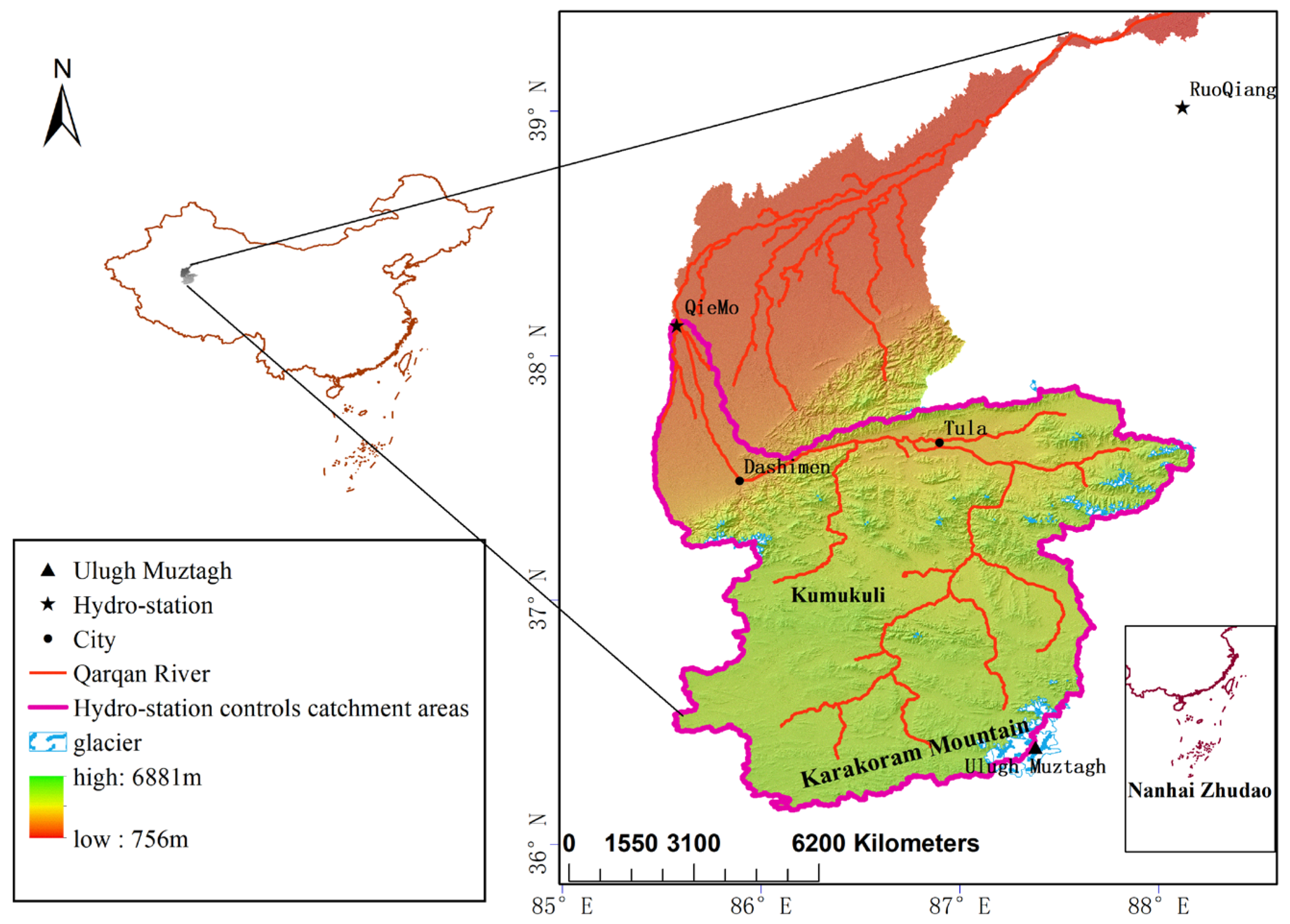
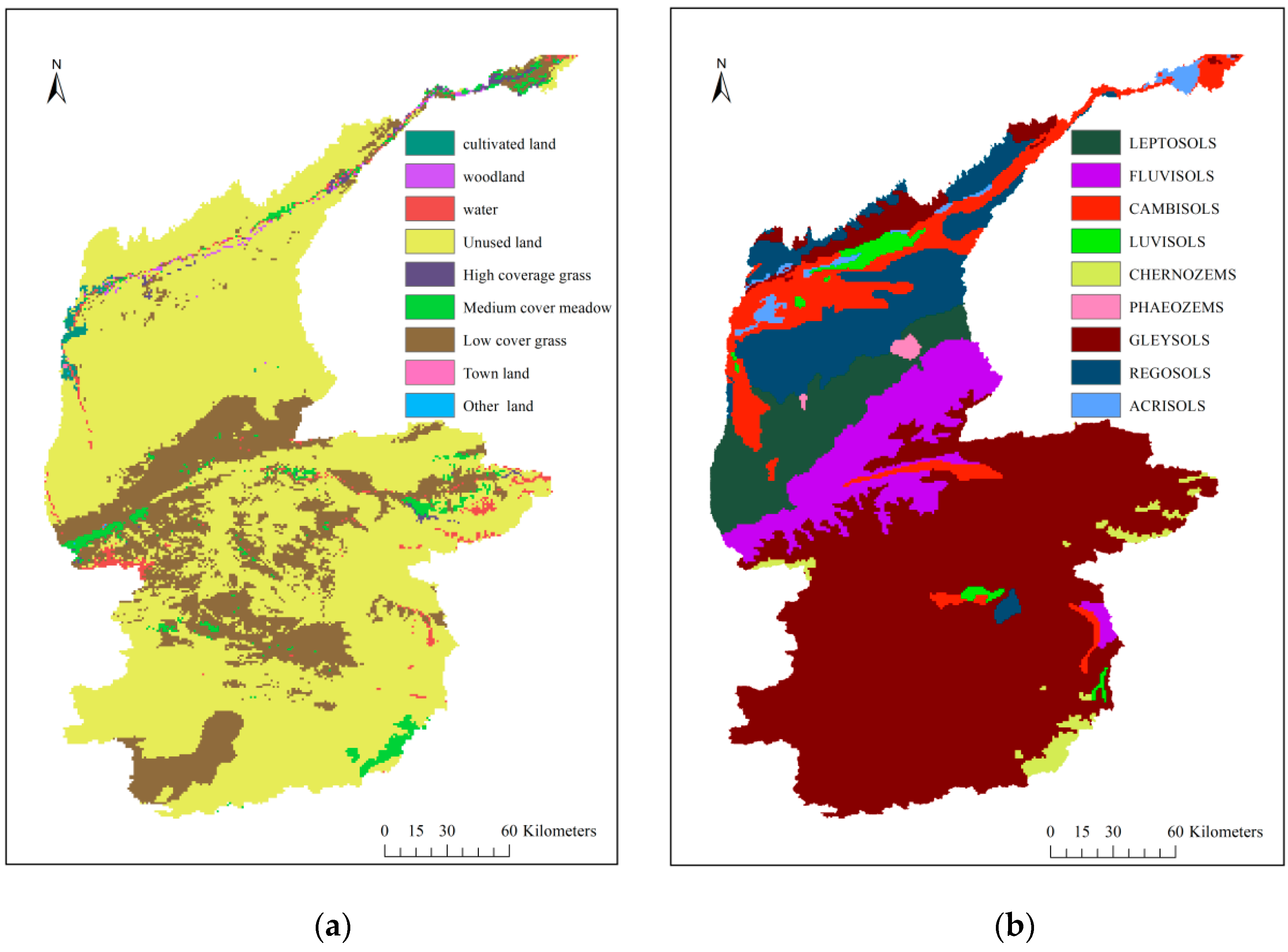
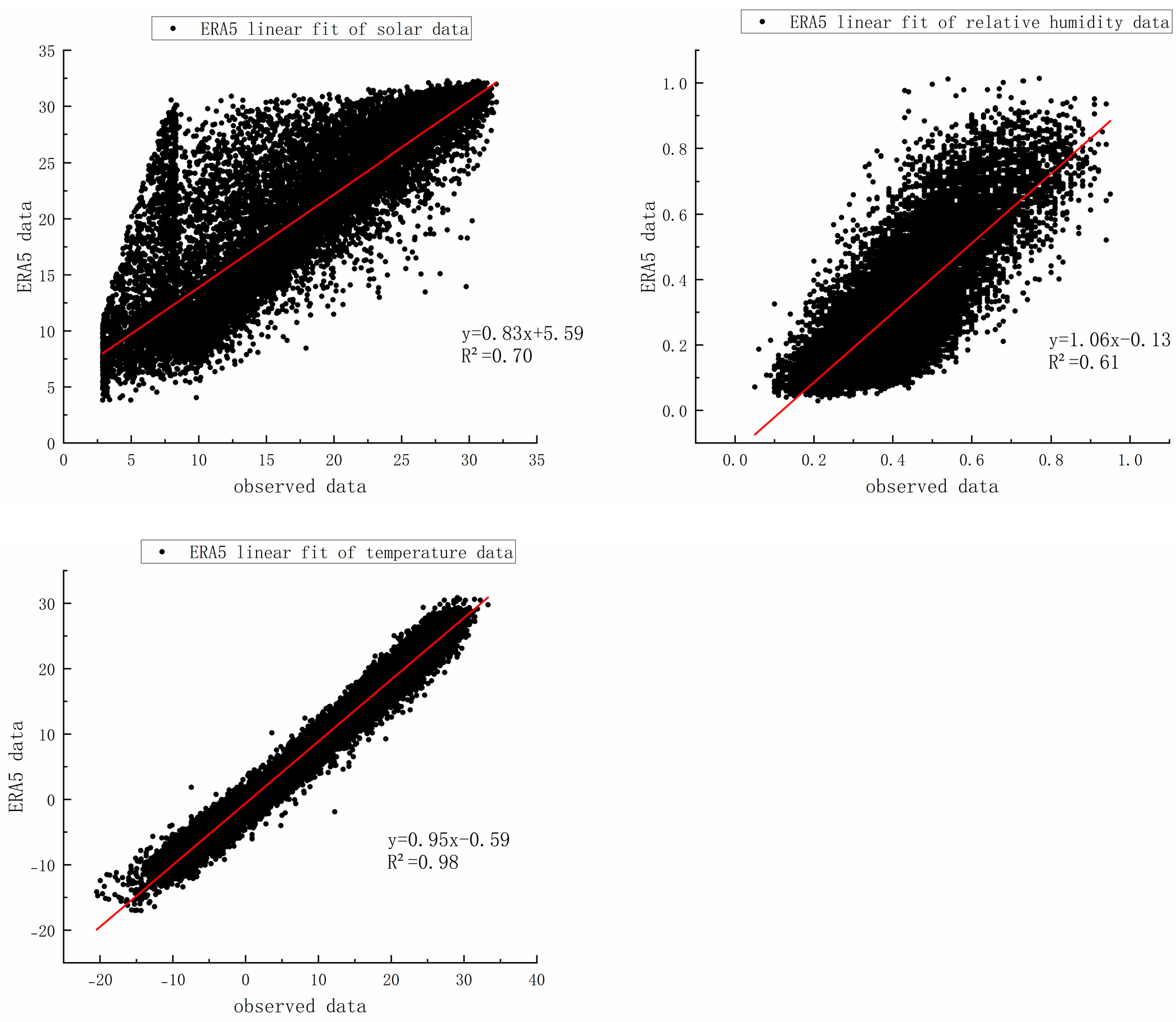
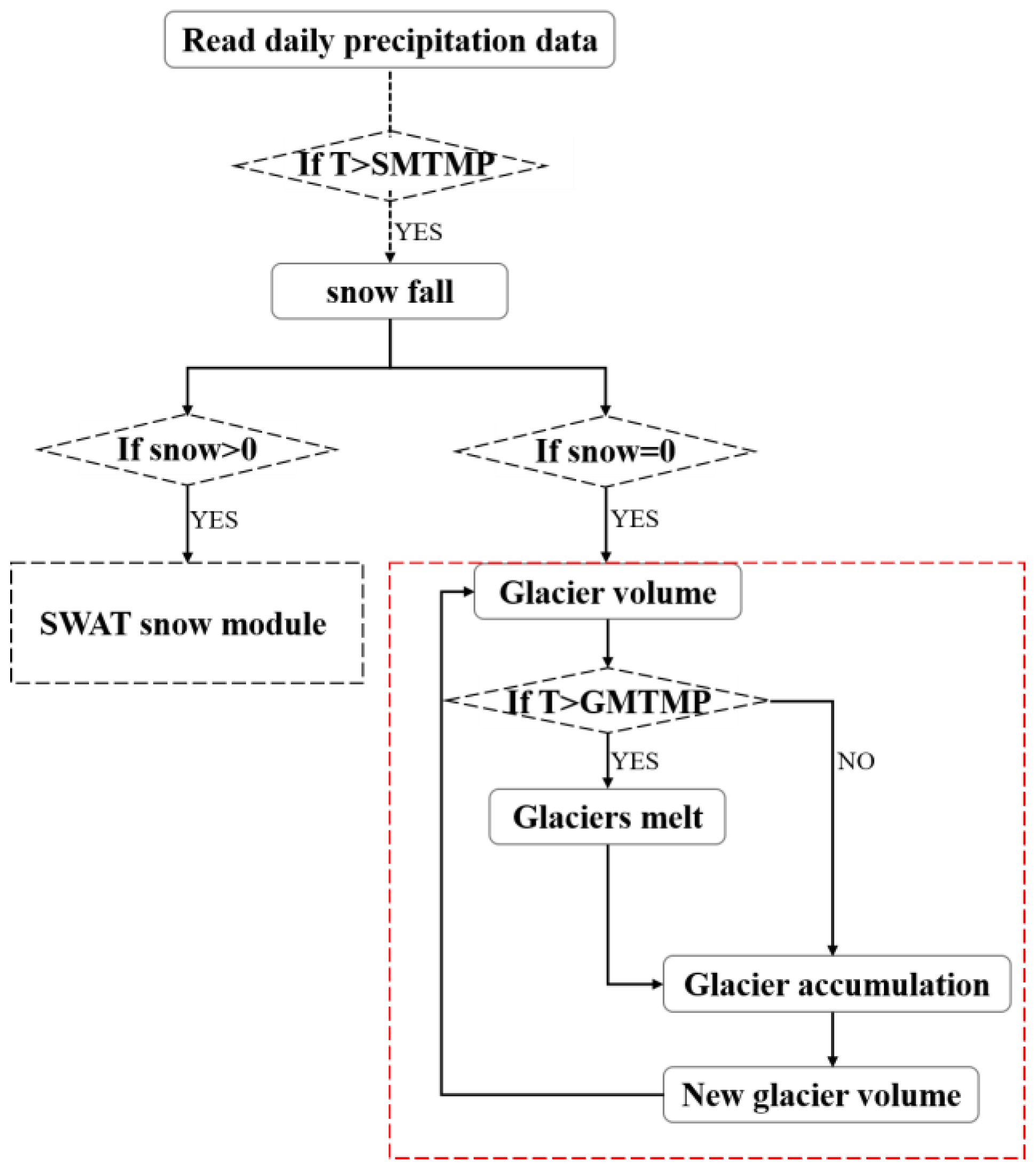


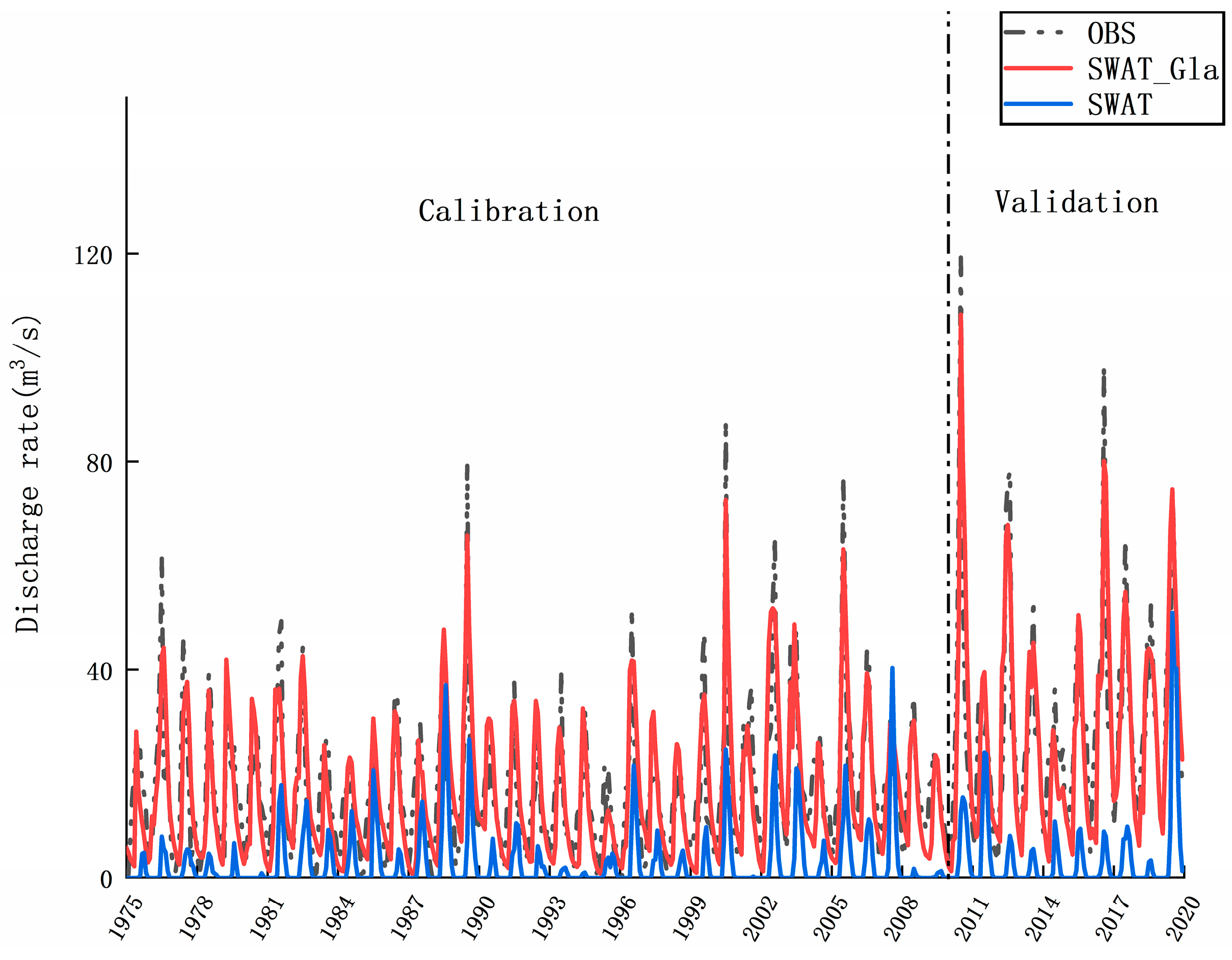

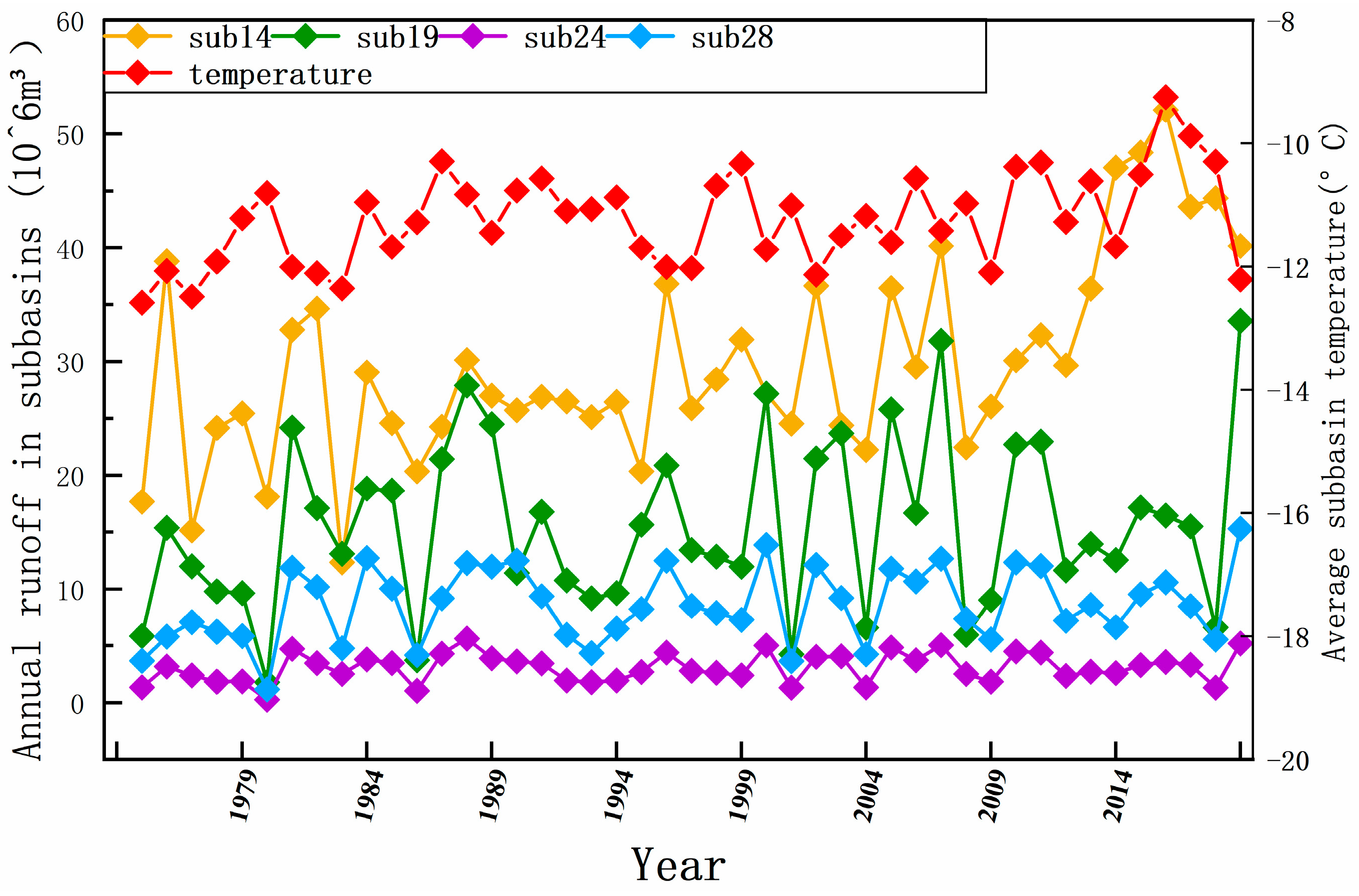
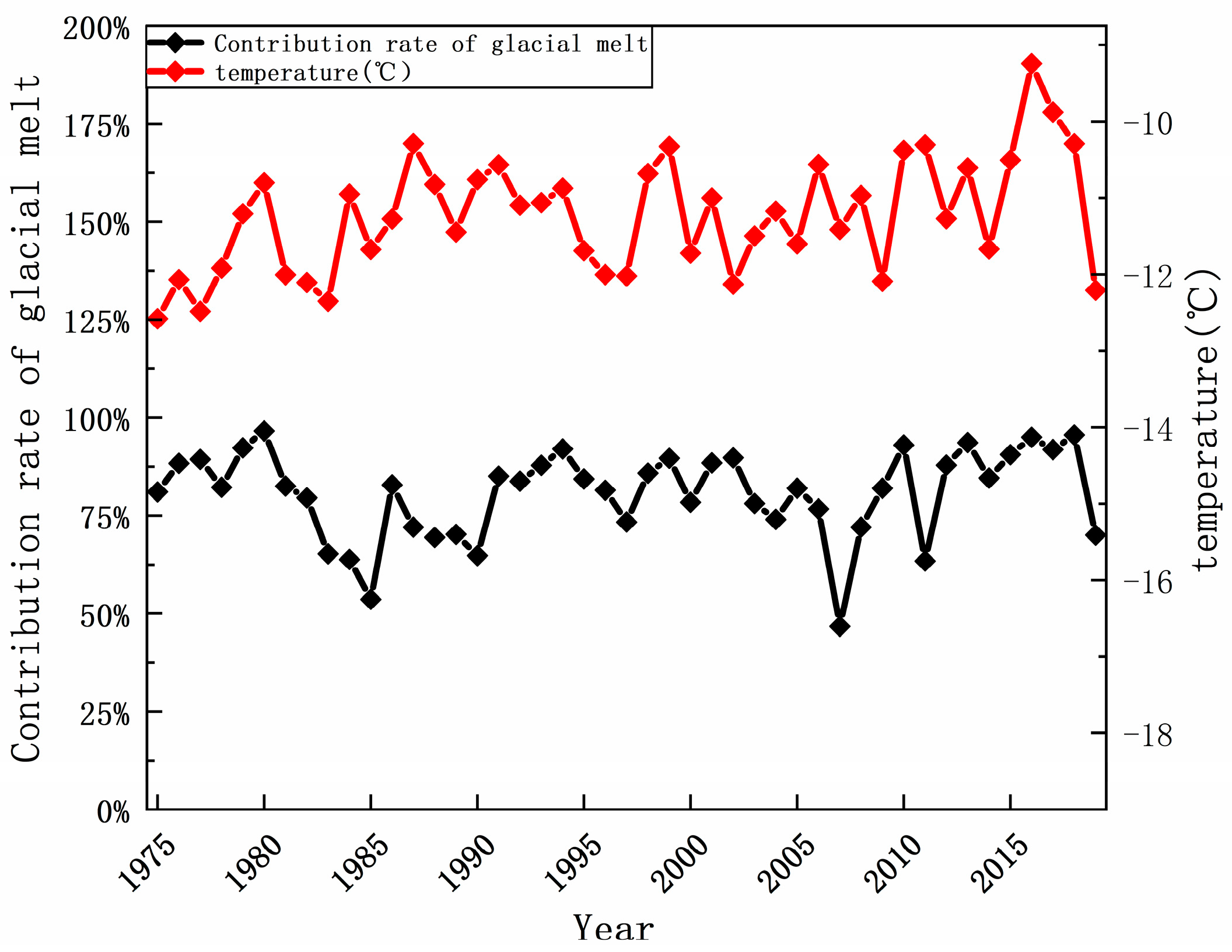

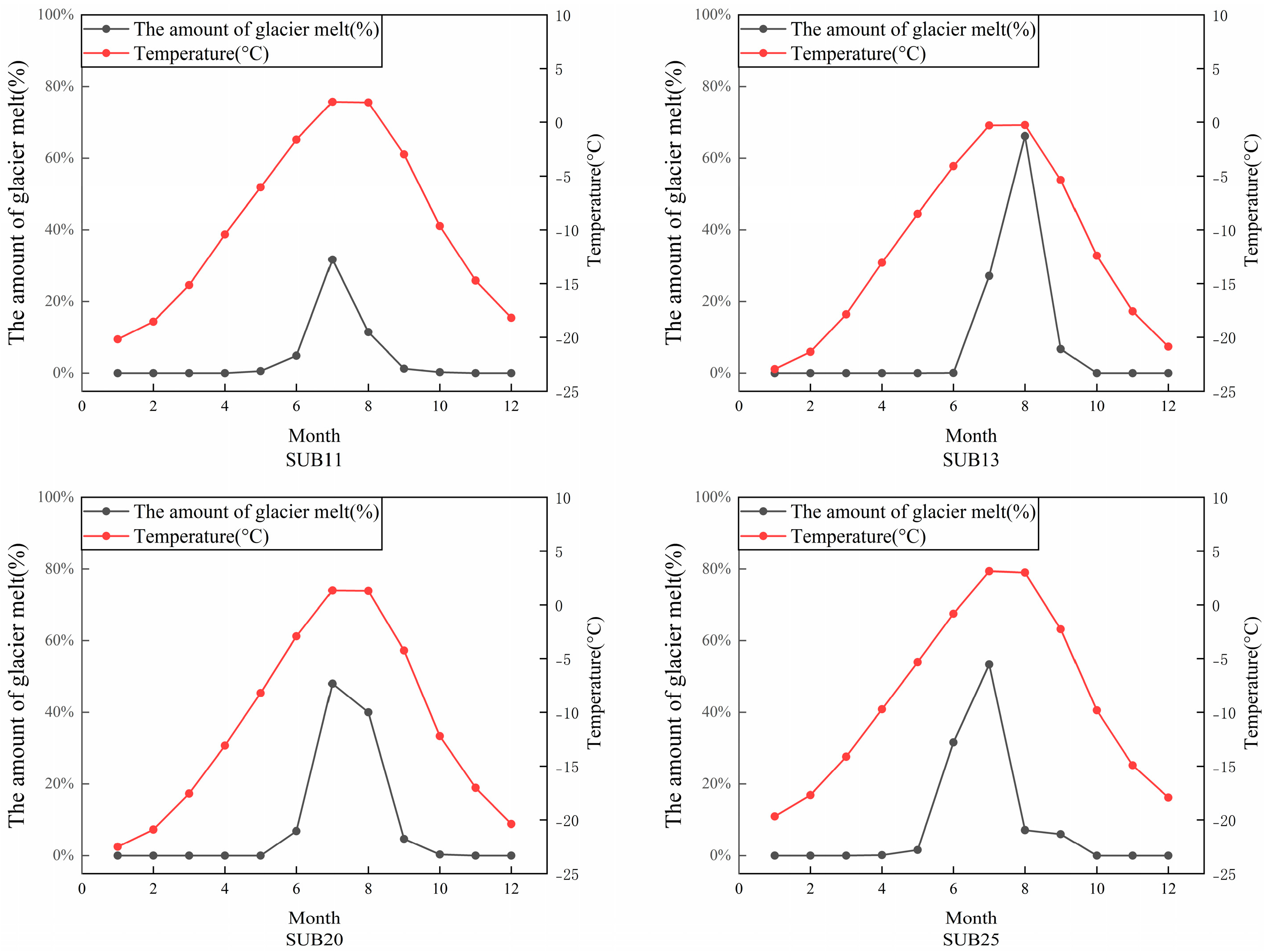
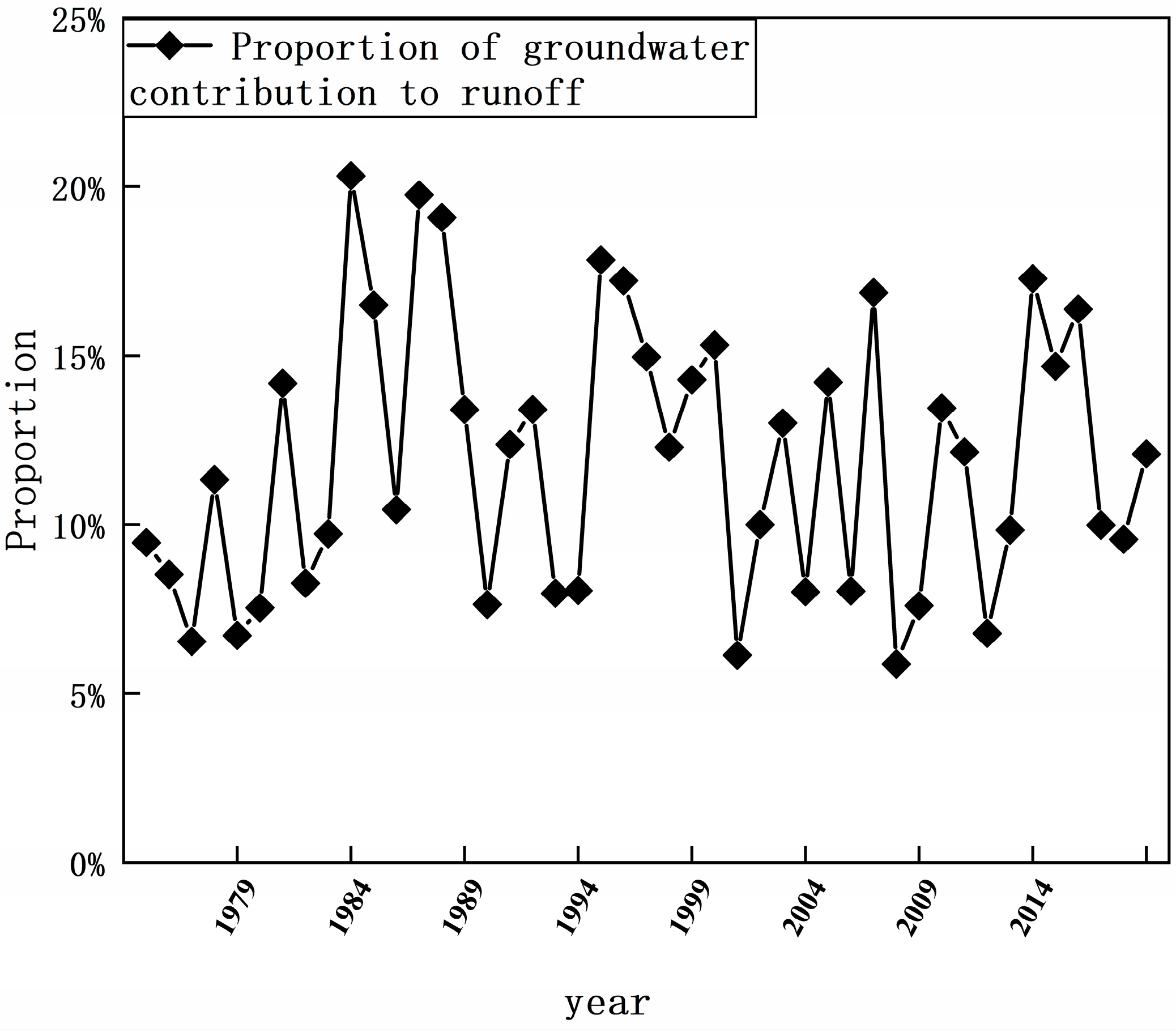

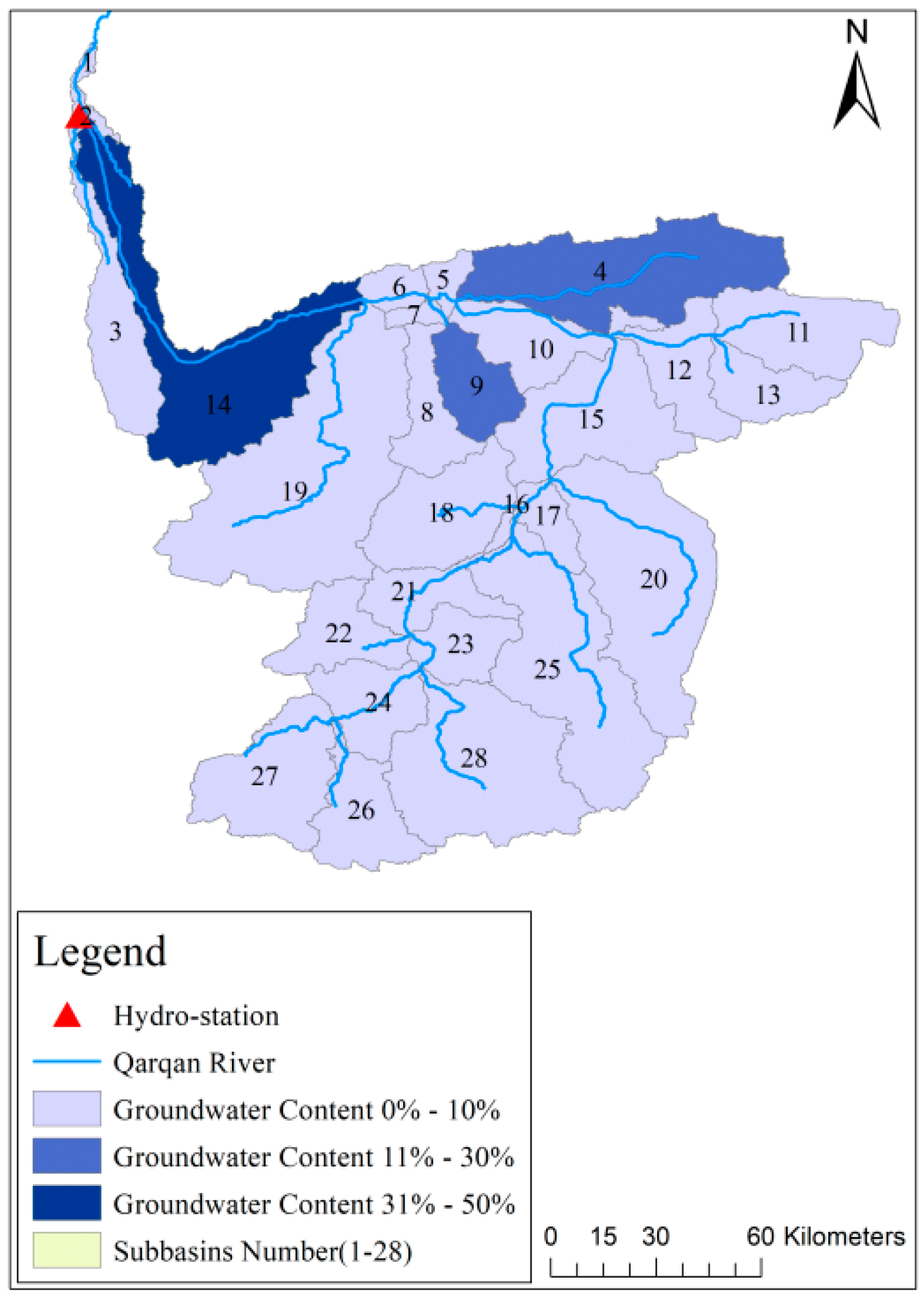
| Data | Data Period (Year) | Resolution | Source |
|---|---|---|---|
| Precipitation data | 1970–2019 | Qiemo station | Daily precipitation data measured by hydrological stations |
| Temperature data | 1970–2019 | 0.1° × 0.1° | ERA5 |
| Solar radiation data | 1970–2019 | 0.1° × 0.1° | ERA5 |
| Wind speed data | 1970–2019 | Qiemo station | Daily precipitation data measured by hydrological stations |
| Relative humidity data | 1970–2019 | 0.1° × 0.1° | ERA5 |
| Model | Parameter | Description |
|---|---|---|
| SWAT parameters | CN2 | Data |
| SOL_K | SCS runoff curve number f | |
| ESCO | Saturated hydraulic conductivity | |
| SOL_Z | Soil evaporation compensation factor | |
| GWQMN | Depth from the soil surface to bottom of the layer | |
| ALPHA_BF | Threshold depth of water in the shallow aquifer required for return flow to occur | |
| SOL_AWC | Baseflow alpha factor | |
| GW_REVAP | Available water capacity of the soil layer | |
| GW_DELAY | Groundwater revap coefficient | |
| CH_K2 | Groundwater delay | |
| CH_N2 | Effective hydraulic conductivity in main channel alluvium | |
| SOL_ALB | Manning’s n value for the main channel | |
| SFTMP | Moist soil albedo | |
| SMTMP | Snowfall temperature | |
| SMFMX | Snow melt base temperature | |
| SMFMN | Maximum melt rate for snow during the year | |
| TIMP | Minimum melt rate for snow during the year | |
| SWAT-Gla Extra parameters | GMFMX | Glacial melt factors for 21 June |
| GMFMN | Glacial melt factors for 21 December | |
| SRF | Solar radiation parameters | |
| GMTMP | Glacial melt base temperature | |
| β0 | Glacial accumulation coefficient |
| Season | Accounts for Annual Runoff (%) | SWAT-Gla | SWAT |
|---|---|---|---|
| Spring | 29.1 | 17.8 | 0.4 |
| Summer | 46.6 | 47.0 | 0.4 |
| Autumn | 16.9 | 25.4 | 62.4 |
| Winter | 7.4 | 9.8 | 36.8 |
| Model | NSE | R2 | PBIAS (%) |
|---|---|---|---|
| SWAT (calibration) | −0.75 | 0.34 | >30 |
| SWAT (validation) | −1.85 | 0.24 | >30 |
| SWAT-Gla (calibration) | 0.60 | 0.65 | 4.6 |
| SWAT-Gla (validation) | 0.72 | 0.75 | 3.9 |
Disclaimer/Publisher’s Note: The statements, opinions and data contained in all publications are solely those of the individual author(s) and contributor(s) and not of MDPI and/or the editor(s). MDPI and/or the editor(s) disclaim responsibility for any injury to people or property resulting from any ideas, methods, instructions or products referred to in the content. |
© 2023 by the authors. Licensee MDPI, Basel, Switzerland. This article is an open access article distributed under the terms and conditions of the Creative Commons Attribution (CC BY) license (https://creativecommons.org/licenses/by/4.0/).
Share and Cite
Ding, J.; Wang, Y.; Cao, C.; Sun, W. Improvement of the Soil and Water Assessment Tool Model and Its Application in a Typical Glacial Runoff Watershed: A Case Study of the Qarqan River Basin, China. Sustainability 2023, 15, 16046. https://doi.org/10.3390/su152216046
Ding J, Wang Y, Cao C, Sun W. Improvement of the Soil and Water Assessment Tool Model and Its Application in a Typical Glacial Runoff Watershed: A Case Study of the Qarqan River Basin, China. Sustainability. 2023; 15(22):16046. https://doi.org/10.3390/su152216046
Chicago/Turabian StyleDing, Junwei, Yi Wang, Chenglin Cao, and Wei Sun. 2023. "Improvement of the Soil and Water Assessment Tool Model and Its Application in a Typical Glacial Runoff Watershed: A Case Study of the Qarqan River Basin, China" Sustainability 15, no. 22: 16046. https://doi.org/10.3390/su152216046
APA StyleDing, J., Wang, Y., Cao, C., & Sun, W. (2023). Improvement of the Soil and Water Assessment Tool Model and Its Application in a Typical Glacial Runoff Watershed: A Case Study of the Qarqan River Basin, China. Sustainability, 15(22), 16046. https://doi.org/10.3390/su152216046







